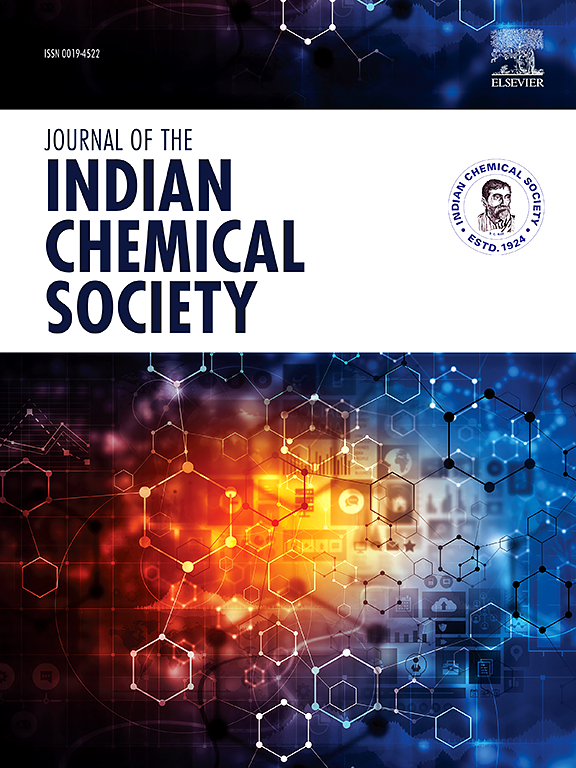Superior photocatalytic degradation of highly photostable R6G dye catalyzed with CuO/ZB-CdS binary heterostructure: catalyst dosage optimization and recyclability for wastewater remediation
IF 3.2
4区 化学
Q2 CHEMISTRY, MULTIDISCIPLINARY
引用次数: 0
Abstract
Cadmium sulphide (CdS) is extensively used as a catalyst for various organic or inorganic pollutant decomposition, heavy metal adsorption, and hydrogen evolution. Continuous efforts are needed to improve its utility by integrating it with appropriate functional materials, such as copper oxide (CuO) with a reduced bandgap that facilitates the charge carrier transition. In this work, copper oxide (CuO) and zinc blende CdS (ZB-CdS) were combined to create a CuO/ZB-CdS binary photocatalyst by a precipitation-impregnation approach. The catalyst dosage was raised to effectively degrade a photostable rhodamine 6G (R6G) dye as a pollutant model under ultraviolet (UV) irradiation. The experimental analysis of XRD, EDS and FTIR confirms the presence of CuO and ZB-CdS in the binary heterostructure. SEM analysis indicates a homogeneous distribution and close interfacial contact of CdS and CuO by preserving their respective morphologies. Absorbance spectra demonstrate a broader band with increased intensity, coupled with bandgap widening, thereby confirming an effective creation and separation of charge carriers in CuO/ZB-CdS. The greatest degradation efficiency accomplished for CuO/ZB-CdS is 94.52 % with a kinetic rate constant of 1.139 × 10−2 min−1 (R2 ≈ 0.913). CuO/ZB-CdS demonstrates a significant breakdown capability after three consecutive recycling cycles, indicating that it might serve as an essential catalyst for future wastewater remediation of diverse hazardous contaminants.

CuO/ZB-CdS二元异质结构催化高光稳定性R6G染料的光催化降解:催化剂用量优化及废水修复的可回收性
硫化镉(cd)被广泛用作各种有机或无机污染物分解、重金属吸附和析氢的催化剂。通过将其与适当的功能材料集成,例如带隙减小的氧化铜(CuO),促进载流子转变,需要不断努力来提高其效用。本研究将氧化铜(CuO)和闪锌矿cd (ZB-CdS)通过沉淀-浸渍法制备CuO/ZB-CdS二元光催化剂。提高催化剂用量,在紫外线照射下有效降解光稳定型罗丹明6G (R6G)染料作为污染物模型。XRD、EDS和FTIR的实验分析证实了CuO和ZB-CdS存在于二元异质结构中。SEM分析表明,cd和CuO保持了各自的形态,分布均匀,界面接触密切。吸收光谱显示,随着强度的增加,带隙的扩大,带宽也随之增加,从而证实了CuO/ZB-CdS中载流子的有效产生和分离。对CuO/ZB-CdS的最大降解效率为94.52%,动力学速率常数为1.139 × 10−2 min−1 (R2≈0.913)。在连续三次循环后,CuO/ZB-CdS显示出显著的分解能力,表明它可能成为未来废水中各种有害污染物修复的重要催化剂。
本文章由计算机程序翻译,如有差异,请以英文原文为准。
求助全文
约1分钟内获得全文
求助全文
来源期刊
CiteScore
3.50
自引率
7.70%
发文量
492
审稿时长
3-8 weeks
期刊介绍:
The Journal of the Indian Chemical Society publishes original, fundamental, theorical, experimental research work of highest quality in all areas of chemistry, biochemistry, medicinal chemistry, electrochemistry, agrochemistry, chemical engineering and technology, food chemistry, environmental chemistry, etc.

 求助内容:
求助内容: 应助结果提醒方式:
应助结果提醒方式:


